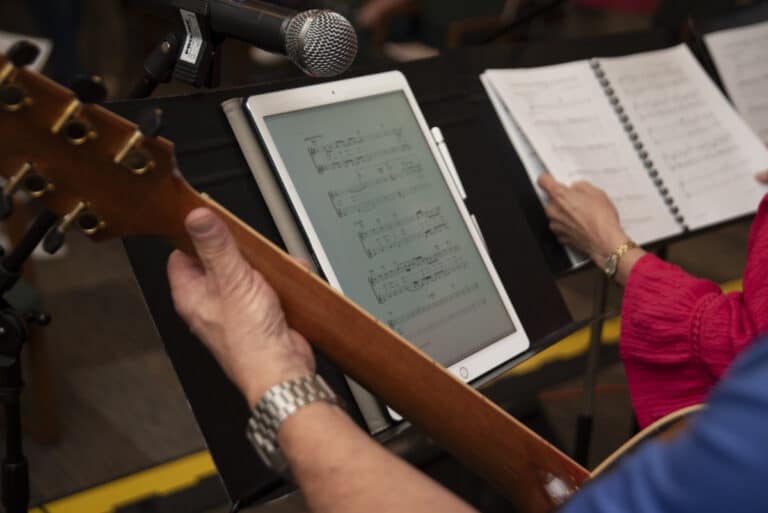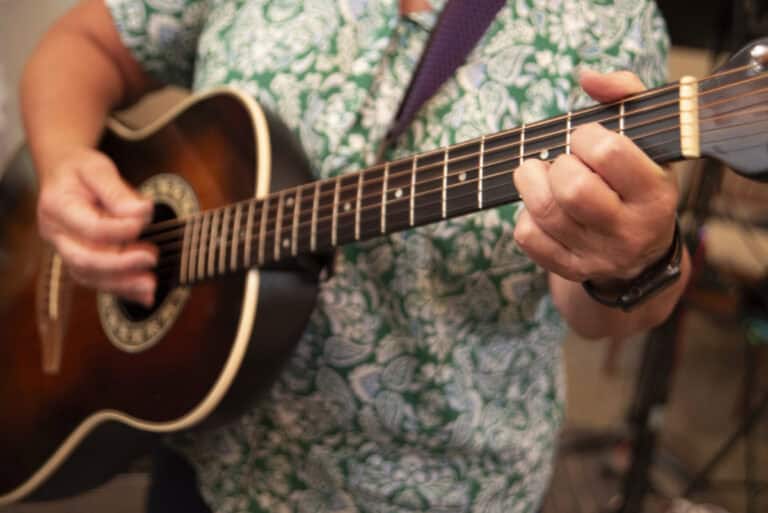In our final article on church documents on music and liturgy, we explore what the documents say about Liturgy of the Eucharist music.
If you missed the prior articles, consider reading part one, part two, and part three before continuing with this article.
For reference, the following abbreviations are used in this article:
- GIRM – The General Instruction of the Roman Missal
- STTL – Sing to the Lord, Music in Divine Worship
- LFM – Lectionary for Mass
Liturgy of the Eucharist
We begin by bringing gifts of bread and wine to the altar. This procession is accompanied by the offertory chant which continues until at least the gifts have been placed on the altar. Singing may always be done at this time even if there is no procession. (GIRM 74) The same norms as discussed with the Entrance chant apply.
Note the optional chant in the order of mass for the prayer, “Pray brothers and sisters…”
The Eucharistic Prayer
Now we reach the center of our celebration. There are multiple Eucharistic Prayers with many choices contained therein. In all cases, this is the prayer of the holy people of God. Led by our priest, we all pray together. The principle developed in Sancrosanctum Consilium of the full participation of the assembly is expressed in the dialogue and acclamations of the prayer. “These acclamations should be sung, especially on Sundays and solemnities.” (STTL 180)
This prayer begins with the preface dialogue and continues to the great amen. In order to express the unity of this one prayer, it is “… recommended that there be a stylistic unity to the musical elements of the prayer. … As much as possible, elements such as the preface dialogue and preface should be chanted at a pitch that best relates them to the key and modality of the other sung elements of the Eucharistic Prayer” (STTL 178) See the Order of Mass for the chant of the Preface Dialogue. Each preface in the Roman Missal has its prescribed chant on the page opposite of the spoken form.
Given the importance of this prayer, especially on Sundays and Solemnities the Church suggests the following:
- Priests should, if possible, sing at least those parts for which musical notation is provided in the Roman Missal.
- It is appropriate for priests to sing the entire Eucharistic Prayer.
- There should be no other prayers or singing, and musical instruments should be silent except for the people’s acclamations. The assembly must be able to hear and participate in this great prayer.
- Concelebrants sing together parts for which musical notation is provided in the Missal. (See STTL 181-183)
The Communion Rite
“Since the celebration of the Eucharist is the Paschal Banquet, it is desirable that in accordance with the Lord’s command his Body and Blood should be received as spiritual food by those of the faithful who are properly disposed. This is the sense of the fraction and the other preparatory rites by which the faithful are led more immediately to Communion.” (GIRM 80)
With this in mind, let us consider carefully how the elements of this rite are structured and prayed.
The Lord’s Prayer
“The invitation, the Prayer itself, the embolism, and the doxology by which the people conclude these things are sung or are said aloud.” (GIRM 81, see the order of Mass or Appendix 1 of the Roman Missal for the chant options.) This is a time for the assembly to pray together. If a sung option is used, it needs be one that the assembly knows and can pray. “When the Lord’s Prayer is sung, the doxology should also be sung by all. If possible, the invitation and embolism should also be sung by the priest.” (STTL 186)
The Rite of Peace
At this time, as part of preparing for sharing in Holy Communion, we pray for peace and unity for all. In the midst of a world where division is rampant, we share in that peace that is beyond our understanding. “The brief period of time needed for the exchange of the Sign of Peace must not be protracted by the singing of a song.” (STTL 187)
The Fraction Rite and the Agnus Dei
The Agnus Dei accompanies the Fraction Rite. “The supplication Agnus Dei (Lamb of God) is usually sung by the choir or cantor with the congregation replying; or at least recited aloud. This invocation accompanies the fraction of the bread and, for this reason, may be repeated as many times as necessary until the rite has been completed. The final time it concludes with the words grant us peace.” (GIRM 83) The Agnus Dei should not be prolonged unnecessarily. (STTL 188) Publishers have many settings for the singing of this text and the chant option is found in the Order for Mass.
Communion Chant/Song
The communion song begins while the priest is receiving communion and continues as long as the assembly is sharing in the sacrament. The GIRM notes that, “Care should be taken that singers, too, can receive Communion with ease.” Also, “However, if there is to be a hymn after Communion, the Communion Chant should be ended in a timely manner.” (GIRM 86)
What shall we sing?
The purpose of the song is to “ … express the spiritual union of the communicants by means of the unity of their voices, to show gladness of heart, and to bring out more clearly the ‘communitarian’ character of the procession to receive the Eucharist.” (GIRM 86)
“In the Dioceses of the United States of America, there are four options for singing at Communion: (1) the antiphon from the Missal or the antiphon with its Psalm from the Graduale Romanum, as set to music there or in another musical setting; (2) the antiphon with Psalm from the Graduale Simplex of the liturgical time; (3) a chant from another collection of Psalms and antiphons, approved by the Conference of Bishops or the Diocesan Bishop, including Psalms arranged in responsorial or metrical forms; (4) some other suitable liturgical chant (cf. no. 86) approved by the Conference of Bishops or the Diocesan Bishop.” (GIRM 87) Recall that in this case chant indicates a song in general, not the particular style chant.
To be clear, our options include songs which reflect:
- the liturgical action of sharing in Christ’s Body and Blood
- the themes of the Gospel of the day
- the wonder, joy, gratitude or the gift of Eucharist
- psalm within the spirit of the season we are celebrating or reflect the Eucharist (STTL 191, 194)
How shall we sing?
The song is intended for the procession. Music that is familiar, at least the refrain, makes it easier for the assembly to sing as they move. If the procession is lengthy, more than one piece of music may be necessary. “In this case, there may be a combination of pieces for congregation and pieces for choir alone. Choirs with the requisite ability may sing the proper Communion chant from the Graduale Romanum, either in Gregorian chant or in a polyphonic setting, or other suitable choral pieces. Instrumental music may also be used to foster a spirit of unity and joy.” (STTL 193)
Silent reflection is also appropriate after the reception of communion. (STTL 193)
Though singing is preferred, “… if there is no singing, the antiphon given in the Missal may be recited either by the faithful, or by some of them, or by a reader; otherwise, it is recited by the Priest himself after he has received Communion and before he distributes Communion to the faithful.” (GIRM 87)
“When the distribution of Communion is over . . . a Psalm or other canticle of praise or a hymn may also be sung by the whole congregation.” (GIRM 88)
With all these options, planning to the season and assembly allows for much variance. More silence in Lent. More joy and exultation at Christmas and Easter. What themes of Eucharist do your assembly sing? What theologies do they place on their lips and in their hearts: Real Presence, communion, banquet, praise? Perhaps evaluate your choices that the richness of our Eucharistic theology is remembered and celebrated.
Concluding Rites
The concluding rites are simple: perhaps announcements, blessing, and dismissal. The last two may be chanted. The chant option is found in the Order for Mass as well as Appendix 1 of the Roman Missal.
While not prescribed, a recessional hymn may be sung. Other options include choral or instrumental music or even silence. (STTL 199)
We hope this series of articles has helped you better understand the church documents on music and liturgy. We recommend that music ministers, whether paid or volunteer, be familiar with these documents and the guidance offered on how music can support full, conscious, and active participation throughout the entire Mass – the Introductory Rites, Liturgy of the Word, and Liturgy of the Eucharist.
Written by Mary Dumm, D.Min, who is a founding board member of CLEF and the pastoral associate at St. Blase Church in Sterling Heights, Michigan. Additionally, she teaches at Siena Heights University and SS. Cyril and Methodius Seminary.
Copyright © 2024 Catholic Liturgical Ensemble Formation
Looking for more resources? Search our full online library of CLEF Life resources, or sign up for CLEF Life email updates to receive the latest resource in your inbox once a week.



